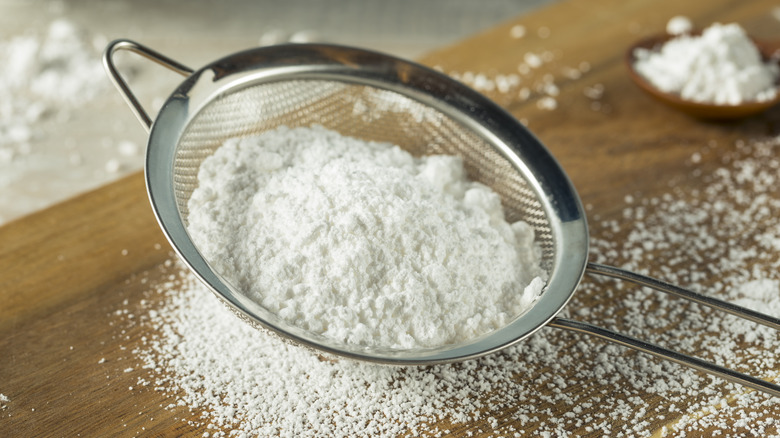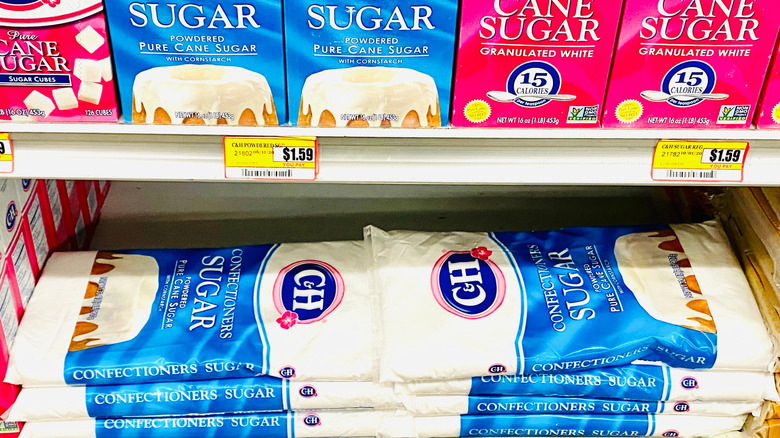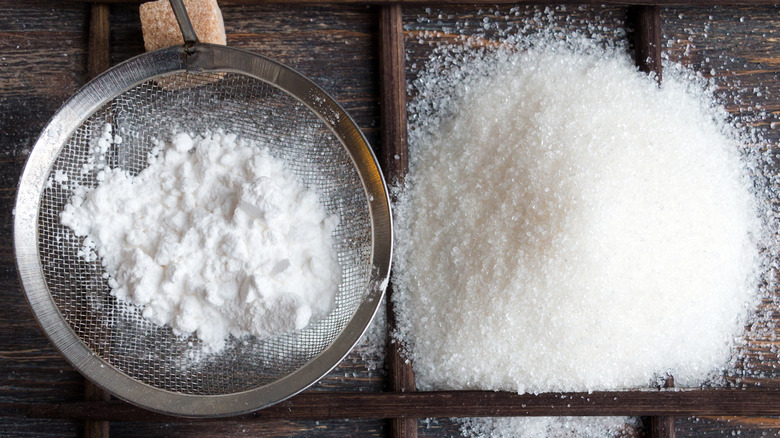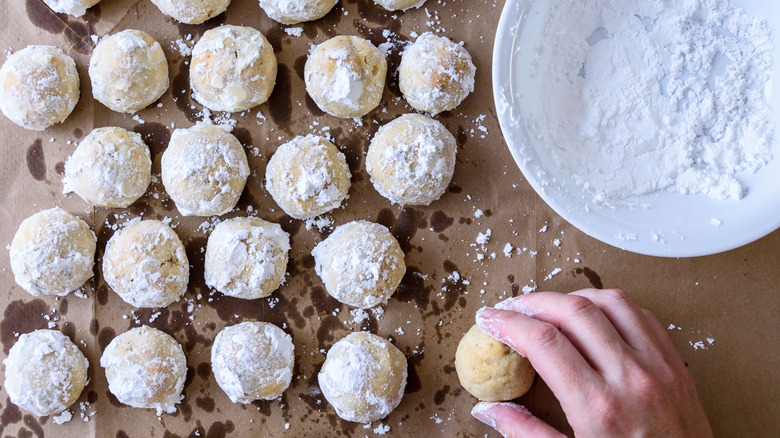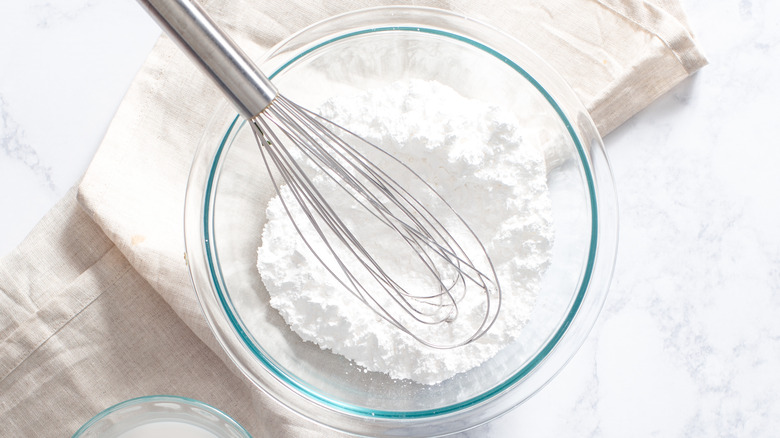What Is Confectioners' Sugar And How Do You Use It?
Confectioners' sugar (aka powdered sugar) is a key cooking ingredient that should be stocked in every at home baker's pantry — in all pantries, really! The fine, powdery sweetener can be mixed into recipes and also sprinkled over cakes and baked goods, with or without a stencil to create a delicate finish and pretty presentation. It also dissolves quickly and easily, making it the ideal sugar to create smooth icings, frostings, and glazes. Even more, confectioners' sugar creates silky fudge, cookies with a tender and crumbly texture, and whipped cream with no traces of grittiness.
SPICEography shares that the earliest form of confectioners' sugar was developed in the 17th and 18th centuries: This is when sugar produced at refineries would vary in texture, so bakers would sift it to separate large crystals from finer ones. By the 1800s, sugar producers perfected methods to grind and sift sugar into very fine particles, creating the confectioners' type we use today. The only other ingredient in confectioners' sugar is cornstarch, which Eat This, Not That! says is to prevent the sugar from sticking together in clumps. That's because all types of sugar easily absorb moisture, and this creates masses that'll show up in your finished dish; however, a small amount of cornstarch blended with the confectioners' sugar prevents this.
There's so many good things to know about this kitchen staple, including ways to use it, and how it differs from granulated sugar.
Is it the same as powdered sugar?
One of the top baking questions that people routinely type into search engines is whether or not confectioners' sugar is the same thing as powdered sugar. The answer? For the confectioners' sugar you buy in a grocery store, yes, they are the same thing. Major sugar producer Domino puts "confectioners' sugar" on its packaging, and also adds a line distinguishing it as "powdered pure cane sugar." My Baking Addiction confirms that the terms powdered sugar and confectioners' sugar are often used interchangeably on packaging and in recipes, which can be confusing to beginner bakers. In these situations, and when you're looking at bags of sweet stuff at the store, you can be confident they are the same: both are finely ground sugar mixed with a small amount of cornstarch.
For professional bakers, however, these two terms do mean different things. According to SPICEography, there are times when bakers don't want the cornstarch in their recipes because it can negatively affect the way the finished product tastes. Confectioners' sugar always contains cornstarch, so instead, professional bakers use powdered sugars labeled by grain size (between 3X and 10X). In this case, pros are purchasing pure, powdered sugar and nothing else. (Tip: If your recipe calls for 10X, that's the same grain size as the confectioners' sugar sold in grocery stores.)
Finally, there's even one more name sometimes used to make it even more confusing. What's Cooking America shares that in Canada and Great Britain, this kind is called icing sugar (as in the type of sugar used to make icing for cakes).
Confectioners' sugar vs. granulated sugar
Both granulated and confectioners' sugars are frequently called for in recipes, and both are key components in a well-stocked baking cupboard. There are, however, important differences between the two in how they dissolve and how they best work in recipes.
Granulated sugar is the common, white sugar most often used for sweetening things like coffee and the go-to in baking recipes. It consists of crystals that you can see and touch, which are created during the sugar-making process as sugar cane or sugar beet juices are boiled down and then refined. Regular, granulated sugar has a fine texture, but there are other sizes of crystals available, too. Superfine sugar has smaller crystals that dissolve quickly, and those labeled as coarse, decorating, or sanding have larger crystals.
The crystals in granulated sugar are what improve baked goods during the step when you cream butter and sugar together. The crystals create pockets of air as they're whipped into the butter, which help give cakes and cookies a light texture.
According to Martha Stewart, confectioners' sugar is then created by grinding down regular sugar crystals into a fine powder. Cornstarch (or other types of powdered starches) are blended in to keep it from clumping, as mentioned earlier. Though both confectioners' sugar and granulated sugar will add sweetness to foods and drinks, the former has a silky texture that dissolves more reliably, so that no grainy crystals are left behind.
How to use confectioners' sugar
Soft and powdery confectioners' sugar is ideal for achieving smooth textures in baked goods and chocolates, as well as liquids where it dissolves quickly at any temperature. With it, you can make super smooth frostings and glazes for cakes (like the perennial favorite buttercream), as well as quick breads, and other sweet treats. Even easier? Simply use it to dust cakes, cookies, Belgian waffles, and other treats for a light pop of sweetness.
Confectioner's sugar is also great for making candies, like this recipe for Domino Sugar's silky Chocolate Walnut Fudge, because it dissolves cleanly without leaving a grainy texture. Though this quality would seem to make it perfect for sweetening drinks, Reddit users point out that the cornstarch in confectioners' sugar leaves an off-taste and thick consistency, so maybe skip it for your sweet tea. The pure powdered sugar prized by professional bakers would likely be a better option for drinks, since it contains no starch.
To create a soft, crumbly texture in shortbreads and butter cookies, you can also use confectioners' sugar instead of granulated. Bon Appétit shares that while the sharp-edged crystals of granulated sugar help aerate cookie batters, the fine texture of confectioners' sugar will create cookies that are more dense, soft, and have a melty feel when you take a bite.
What to substitute for confectioners' sugar
If your recipe calls for confectioners' sugar, but all you have on hand is the regular granulated kind, good news: You can make your own! Simply grind one cup of granulated sugar with one tablespoon of cornstarch in a high-speed blender or in a clean spice grinder until the texture is very fine and soft. Not surprisingly, this will create a lot of sugar dust, so cover your workspace with a dishtowel first! Then, sift the blended sugar to remove any large crystals, and it's ready to use. You can also try this hack with organic and coconut sugars.
The Spruce Eats shares that you can also create a sugar-free confectioners' sugar by grinding one cup of bulk Splenda (look for it in the baking aisle) with a teaspoon of cornstarch. They note that this sugar-free version won't have the same effect in baked goods as regular confectioners' sugar, but it's great for sifting over cookies, cakes, and candies, and worth experimenting with in your baking and frosting recipes.
For a straight swap of granulated in place of confectioners' sugar, Betty Crocker recommends using one cup of granulated for every 1-3/4 cups of confectioners' sugar. They do note, however, that the granulated sugar may affect recipes differently because it doesn't have the fine, powdered texture. Love To Know also cautions that icings made with granulated sugar will be gritty, and it's better to save this substitution for cookies and other baked goods instead.
